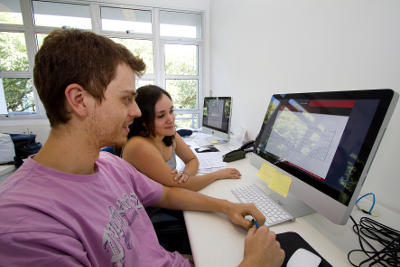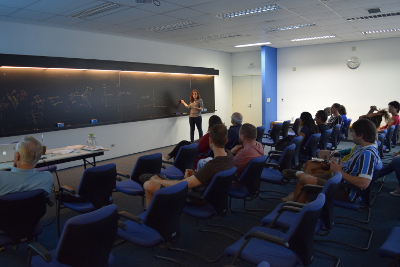
Advances in the modelling of a system of interacting neurons
Apr 18, 2015
How do the membrane potentials of a set of neurons evolve across time? How may we account for influences on these membrane potentials? These questions have been at the core of the scientific agenda of the Research, Innovation and Dissemination Center for Neuromathematics (NeuroMat), that is dedicated to integrating mathematical modelling and theoretical neuroscience and is funded by the São Paulo Research Foundation (FAPESP).
NeuroMat researchers Aline Duarte and Guilherme Ost, advanced PhD candidates at the Institute of Mathematics and Statistics, University of São Paulo (IME/USP), have advanced a model of a finite system of interacting neurons in the absence of external stimuli that account for electric and chemical synapses and leak currents. This model that combines random point events with deterministic continuous evolutions appeared at the end of 2014 here and was accepted for publication.
 |
In Duarte and Ost’s model, electric synapses and leak currents remain deterministic. Thus, if no spike occurs between consecutive spikes neuronal potentials will be the result of the interplay of these deterministic factors. Electric synapses happen due to specific channels among neurons which lead to a constant sharing of potentials. The sharing of potentials lead the whole system of interacting neurons to an average value — the rationale here is that the system tends to distribute continuously equal shares of potential across neurons. Leak currents may be defined as flows of potentials that are lost to the environment; each neuron tends individually to the resting state and if no other influence occurs it will remain in this state.
Chemical synapses remain random point events in the model. Spikes occur randomly across time with a rate proportional to the membrane potential. When a neuron spikes, its membrane potential is reset to the resting potential. At the same time, neurons that a spike influences receive an additional positive value to their membrane potential, that is determined according to an interaction graph.
Duarte and Ost's model takes into account the evolving dynamics of the three influences on neuronal potentials and show that in the long run the existence of leak currents is expected to determine whether the system remains active or not in the absence of external stimuli. An inactive state is when no spike ever occurs, which is referred to as "brain sleep." This is true, so the researchers claim, even in cases when the rate of leakage is small. If the leaking is disregarded, the system stays active in the model.
 |
“We have advanced a simple model, which is not to say that it remains simplistic,” said Duarte. “The study of the behavior of interacting neurons the way we do may contribute to determining the long-run behavior of the process.” Duarte and Ost’s model appears as a contribution to NeuroMat's ongoing project of a mathematical framework for neuroscience, specifically to models presented by A. Galves and E. Löcherbach (2013), here, and by A. De Masi, A. Galves, E. Löcherbach, and E. Presutti (2014), here. Duarte and Ost spent the last term in 2014 working with Prof. Pressutti at the Gran Sasso Science Institute, University of L’Aquila, Italy.
Link to paper
This piece is part of NeuroMat's Newsletter #14. Read more here
Share on Twitter Share on Facebook| NeuroCineMat |
|---|
|
Featuring this week: |
| Newsletter |
|---|
|
Stay informed on our latest news! |
| Follow Us on Facebook |
|---|




